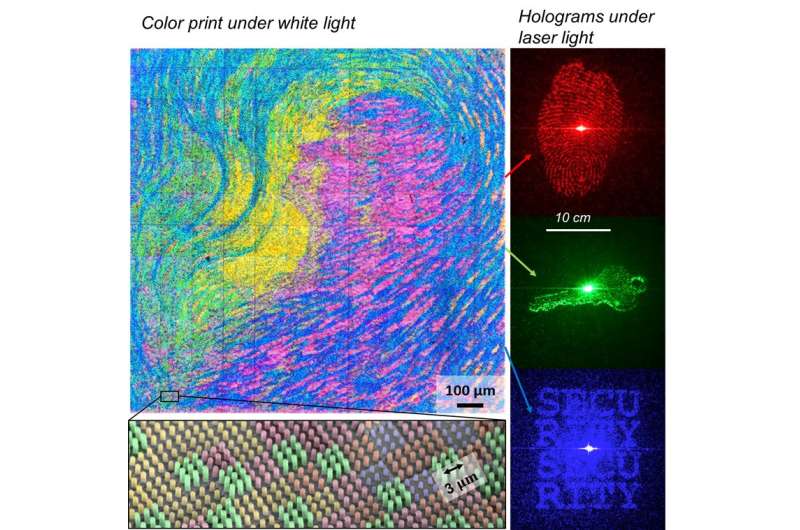Holographic color printing for optical security

Researchers from the Singapore University of Technology and Design (SUTD) have invented a new type of anti-counterfeiting technology called holographic colour prints for securing important documents such as identity cards, passports and banknotes. The research team led by Associate Professor Joel Yang demonstrated an optical device that appears as a regular colour print under white light, but projects up to three images onto a distant screen when illuminated with laser light. Unlike regular diffractive optical elements that have a frosted-glass appearance and project only single images, these new holographic colour prints would comprise a stronger deterrent to counterfeiters. In addition, the prints consist of nano-3-D-printed polymer structures and find particular use in optical document security.
Counterfeiting is prevalent, and the global anti-counterfeiting industry will reach more than US $357 billion by 2026, according to a report from Credence Research. Anti-counterfeiting products are essential for protecting products and documents. The most popular anti-counterfeiting products are based on holograms, commonly used on electronic device packaging, medicine bottles, and the surfaces of bank cards. However, these anti-counterfeiting hologram products only modulate the phase of light and can be easily copied.
The SUTD research team developed a new anti-counterfeiting measure, holographic colour printing, which modulates both the phase and amplitude of light. Holographic colour printing displays a coloured image under ambient white light by tuning the amplitude of light, while projecting up to three holograms under red, green or blue laser illumination. This was achieved by fabricating a new type of nanostructured pixel strategically arranged on a plane. Each pixel acts as a speed bump (phase control) and a road block (amplitude control) for light. The dual function of holographic colour printing increases security and deters counterfeiting.
Associate Professor Joel Yang says that the device's colour pixels are created by overlaying structural coloured filters onto phase plates. Nanostructured posts of different heights are employed as structural coloured filters to modulate the amplitude of light. The team developed a computer algorithm that takes multiple images as its input, and generates an output file that determines the positions of different phase and coloured filter elements. The holoscopic print was then sculpted with the aid of a nanoscale 3-D printer. The team used Luigi Russolo's art painting Perfume (1910) as a colour print that is viewable under ambient white light. Different thicknesses of polymerised cuboids are used to modulate the phase plates and form three multiplexed holograms, projected as a red thumbprint, a green key, and blue lettering that reads "SECURITY." All of these images were embedded within a single print.
"The relationship of holograms in combating counterfeiting is analogous to antibiotics against infections. Every so often, new technology is needed to deter counterfeiters as the old holograms become easier to copy," said Joel Yang. "For the first time, multiple holograms that are color selective are 'woven' into a colourful image using advanced nanofabrication techniques. We are hopeful that these new holographic colour prints are user friendly but counterfeiter unfriendly: They are readily verified but challenging to copy, and can provide enhanced security in anti-counterfeiting applications."
More information: Kevin T. P. Lim et al, Holographic colour prints for enhanced optical security by combined phase and amplitude control, Nature Communications (2018). DOI: 10.1038/s41467-018-07808-4
Journal information: Nature Communications
Provided by Singapore University of Technology and Design




















